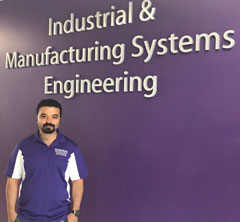July 1, 2021
Industrial and manufacturing systems engineering graduate student wins outstanding paper award

Halil Tetik, K-State industrial and manufacturing systems engineering graduate student, was recognized for having a 2021 North American Manufacturing Research Institution Conference Outstanding Technical Paper in the manufacturing processes track by the institution's scientific and honors committee for his work, "3D Freeze-printed Cellulose-based Aerogels: Obtaining Truly 3D Shapes, and Functionalization with Cross-linking and Conductive Additives."
In the research covered in the paper, Tetik, along with Keren Zhao, graduate student in industrial engineering; Nasrullah Shah, former visiting Fulbright research scholar from Pakistan; and Dong Lin, associate professor in industrial and manufacturing systems engineering, achieved the fabrication of 3D-printed aerogels based on cellulosic nanomaterials that can be customized and personalized for specific applications.
Cellulose is the most abundant natural polymer existing on earth and nanomaterials derived from it have been used in a variety of applications due to their superior properties over bulk cellulose. Aerogels are hıghly porous materials that can achieve ultra-low densities. Even though they have fıxed volume and shape as solids, their density can be lower than air. Aerogels made from cellulose nanoparticles have been reported as promising materials for biomedical and pharmaceutical applications, electrical devices, energy storage systems, thermal insulators and fire retarders.
In their 3D printing method, the team from K-State fabricated truly 3D structures by using water as support material and removing it from the main structure without thermal or chemical etching processes. They further used a wet-strength additive in their ink formulation to provide structural integrity to the 3D-printed aerogels. These can be used in biomedical applications such as tissue engineering or wound healing. They were also able to show that by adding a conductive polymer additive in the ink formulation, their 3D-printed cellulose-based aerogels can be used for piezoresistive sensing and flexible electronics.
